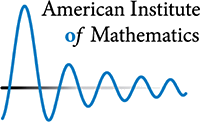
New Tools for Old Problems
When mathematicians notice connections between two distinct areas of their discipline, you can be sure something interesting will develop. That is exactly what happened at a recent workshop at the American Institute of Mathematics (AIM). The scientific advisory board of AIM noticed that new methods in ergodic theory, a subject arising from mathematical physics, may have applications in other...

Neuronal Network
Modeling the Dynamic Range of a Neuronal Network for Breathing For humans and other mammals, breathing is essential to life. The breathing rhythm relies on an area of the brain stem known as the pre-Bötzinger complex, a network of neurons exhibiting rhythmic bursts of activity that initiate inspiration. The frequency of the rhythm varies in response to such challenges as exercise, sleep, or...

Symmetry in 248 Dimensions
A Calculation the Size of Manhattan Mathematicians have mapped the inner workings of one of the most complicated structures ever studied: the object known as the exceptional Lie group E8. This achievement is significant both as an advance in basic knowledge and because of the many connections between E8 and other areas, including string theory and geometry. The magnitude of the calculation is...

Mind-Bending Math
When viewed from the outside, a human brain appears as a volume with a highly wrinkled surface having numerous long crevices. Sulcal fundi are 3D curves that lie in the depths of the cerebral cortex; informally, the fundus of a sulcus is the curve of maximal average depth that spans the length of the sulcus. The sulcal fundi serve as anatomical landmarks, ‘segmenting’ the cortex into...

Spatial Model for Rabies
A human bitten by an animal with rabies will almost certainly die within days unless immediately treated with a multi-stage vaccine regimen initially developed by Louis Pasteur in 1885. To combat the spread of rabies today, which nationwide affects over 40,000 people annually and countless wild and domestic animals, the United States spends over $300 million each year on its prevention and...

Alimentary Math
Meat and soybeans are two important food sources in many parts of the world, and in the form of biodiesel fuel, soybeans are a promising source of renewable energy. Two groups of long-term visitors to the IMA during our 2005-2006 program on imaging are contributing to the improved production of these important foodstuffs. For beef, the rib eye area is an important indicator of the meat quality...

Low X-ray Exposure Imaging
The ability to “see” inside a human body has been of tremendous value to medical diagnostic. For example, it is almost impossible to properly diagnose brain tumor without being able to image the patient’s head, and very difficult to plan the complex surgery of removing the tumor without accurate three-dimensional visualization of the brain itself. A prevalent method to see our way inside a...

Stratification Learning
Data in high dimensions is becoming ubiquitous, from image analysis and finances to computational biology and neuroscience. This data is often given or represented as samples embedded in a high dimensional Euclidean space, point cloud data, though it is assumed to belong to lower dimensional manifolds. Thus, in recent years, there have been significant efforts in the development of methods to...

Homological Mirror Symmetry
During the academic year of 2006-2007 the School of Mathematics conducted a special program in algebraic geometry. This subject, with deep classical roots, is one of the most active areas in contemporary mathematics. Especially notable are its interconnections with number theory, mathematical physics and topology. The scientific activities during the year reflected the depth and breadth of...

Traffic Gridlock
In studying traffic flow in a large city grid, the following questions arise. Is there a largest traffic density that permits free flow? Is there a density above which gridlock is inevitable? In 1992 Biham, Middleton and Levine introduced a simplified model for the study of these questions, called the BML model. This simplified model proved to be surprisingly complex – in a series of papers...